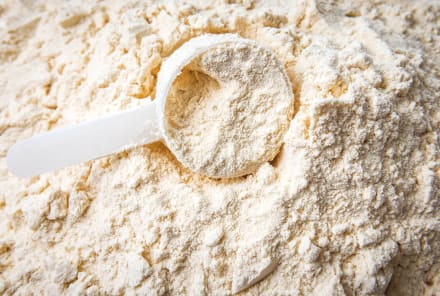Advertisement
What Stem Cells Really Are + How To Boost Them Naturally For Regenerative Health


Ashley Jordan Ferira, Ph.D., RDN is Vice President of Scientific Affairs at mindbodygreen. She received her bachelor's degree in Biological Basis of Behavior from the University of Pennsylvania and Ph.D. in Foods and Nutrition from the University of Georgia.
The results of an important 2018 study1 in the journal Cell Stem Cell showing that fasting for 24 hours augmented stem cell function in mice blasted the headlines of every major news outlet.
The actual study1 (again, a preclinical mechanistic study in mice) is a bit dense and techinical for anyone who's not a researcher to understand. Yet being familiar with what stem cells are, why you might want more of them, and natural and safe ways to increase stem cell activity are timely topics that all of us should know.
So what are stem cells, anyway?
Stem cells2 are a type of cell that has the potential to develop into different cell types in the body. Because of this, these types of cells can serve as a repair system and theoretically divide without limit to replenish other cells for as long as you are alive.
When a stem cell divides, each "daughter" cell has the potential to either remain a stem cell or become another type of cell with a more specialized function, such as a heart muscle cell, a red blood cell, or a brain cell.
In theory, the best scenario would be to increase the quantity of stem cells while we are young and then use them to keep our heart, joints, brain, and other parts of our body healthy as we age.
How can we boost stem cells?
There are a few well-known methods for accessing stem cells that can be used for serious medical conditions and situations. These are considered stem cell-based therapies3 and are used in the specialty of regenerative medicine. Keep in mind that these strategies would not be used for just any health and wellness program but instead, under medical supervision and for a specific medical issue.
The invasive methods (some more invasive than others) used to access stem cells in humans include:
- Bone marrow4 stores, which can be harvested by drilling into bone for a biopsy.
- Adipose/fat cells5, which can be harvested by liposuction.
- Blood extraction6 by apheresis, a machine in blood banks that looks like a dialysis unit.
In the 2018 study that garnered attention for the effect of fasting on stem cells1, the research team fasted mice acutely (for 24 hours) and then harvested stem cells from their intestines. They grew the stem cells in a culture and measured their activity. They found that fasting caused fatty acid oxidation in these intestinal stem cells, and the regenerative capacity of these cells doubled compared to mice that did not fast.
This important scientific finding in rodents fits well with the broader body of research that nutrition—or temporary absence thereof during fasting—has profound effects on the behavior of cells and the maintenance of health, even in humans7.
The principal investigator on this seminal fasting/stem cell study in mice, Ömer H. Yilmaz, M.D., Ph.D., shared the possible future implications on his research, that "fasting has many effects in the intestine, which included boosting regeneration as well as potential uses in any type of ailment that impinges on the intestine, such as infections or cancers."
Although mice may show changes in stem cell function after just 24 hours, in humans, studies indicate prolonged fasts (several days) may be used to trigger stem-cell-based regeneration that rejuvenates the immune system. This hopeful idea was studied by the team at University of Southern California led by Valter D. Longo, Ph.D., and initial results were published8 in 2014.
Using two to four days of a fasting-mimicking diet (FMD) in patients undergoing chemotherapy for various cancer diagnoses, patients experienced protection from the toxicity of treatments. The study has profound implications for promoting healthier aging processes, as immune cell function and protection from disease declines with age.
Using fasting (something our ancestors regularly practiced, due to food scarcity) to theoretically kill older and damaged intestinal cells or immune cells and replacing them with stem-cell-derived new ones opens doors to regenerative biohacking. In other words, a practical lifestyle method to make your stem cells work for you. In the words of Longo: "We could not predict that prolonged fasting would have such a remarkable effect in promoting stem-cell-based regeneration."
Can we all use fasting to augment stem cells or regenerative processes?
Although not directly increasing stem cells (like the rodent studies elegantly demonstrate), a pivotal and rigorously designed randomized, controlled cross-over trial9 research published in 2017, does demonstrate cellular clean-up and regeneration following fasting.
The study included 100 healthy individuals; 71 ultimately completed a fasting-mimicking diet (FMD) regimen (800 to 1,100 calories daily of a plant-based diet low in protein and simple carbohydrates that is commercially available) for five consecutive days a month for three months in a row. In contrast, the control group consumed an unrestricted diet every day.
Compared with the control group, the intervention group following the prolonged "fast" experienced a reduction in body weight, abdominal fat, blood pressure, fasting glucose, lipids (total and LDL cholesterol), inflammation (C-reactive protein), and a tumor marker called IGF-1. The FMD results were so compelling, Longo and colleagues received a patent.
This important clinical trial9 demonstrated safety of the FMD and efficacy in reducing key biomarkers (risk factors) involved in aging, metabolic health, and chronic disease. The clinical trial results were so compelling, Longo and colleagues received a patent.
More research on FMD and intermittent fasting is currently underway in humans and has produced regenerative and even anti-aging results10 across a variety of patient groups. Fasting has been shown to positively affect:
Fasting personally helped improve my health.
As a personal testimonial, after completing three months of a FMD, I found that a sore right shoulder and a right foot plantar fasciitis had resolved and those issues remain at bay. This was accompanied by the perk of an 18-pound weight loss and a similar drop in systolic blood pressure.
While I cannot be certain it was the regenerative activity of stem cells repairing damaged cells, it is good to know that we all have ways to utilize our natural reparative pathways and get ourselves back to optimal health!
Are there any other natural ways to activate stem cells?
So we know that fasting can help stimulate stem cell production (definitely in mice; more to come from human studies), that raises the question: Are there are any other natural activators of stem cells? It looks like yes, and the compounds are botanical bioactives.
Although the work is preliminary (again, basic science from animal and cell models), there is a growing amount of data that show phytochemicals (specifically polyphenols) confer antioxidant and anti-inflammatory properties that protect and benefit stem cells.
There are thousands of unique polyphenols. The best-studied ones for stem cell benefits16 include resveratrol, curcumin, quercetin, EGCG, genistein, daidzein, caffeic acid, chlorogenic acid, kaempferol, and piceatannol. The mechanisms from this preclinical research has definite potential for positive implications in cancer, cardiovascular, and neurocognitive disease processes, to name a few.
The top food sources of polyphenols are all healthy. They include fruits, vegetables, whole grains, legumes, nuts, dark chocolate, tea, herbs, and spices.
Finally, in addition to a healthful diet, physical activity may support stem cell health too. Research17 in mice indicates that bouts of acute exercise18 increase stem cells in the circulation.
Want to know more about the fasting-mimicking diet? This mbg contributor tried it for five days: here's what she learned.

Dr. Joel Kahn is the founder of the Kahn Center for Cardiac Longevity. He is a summa cum laude graduate of the University of Michigan School of Medicine and is a professor of medicine at Wayne State University School of Medicine. He is owner of GreenSpace Cafe in Ferndale, Michigan. His books, The Whole Heart Solution, Dead Execs Don't Get Bonuses, and Vegan Sex are all available for sale now.
More from the author:
Functional Nutrition Training
Check out Functional Nutrition Coaching
A cutting-edge nutrition deep dive taught by 20+ top health & wellness experts
Learn moreMore from the author:
Functional Nutrition Training
Check out Functional Nutrition Coaching
A cutting-edge nutrition deep dive taught by 20+ top health & wellness experts
Learn more
Dr. Joel Kahn is the founder of the Kahn Center for Cardiac Longevity. He is a summa cum laude graduate of the University of Michigan School of Medicine and is a professor of medicine at Wayne State University School of Medicine. He is owner of GreenSpace Cafe in Ferndale, Michigan. His books, The Whole Heart Solution, Dead Execs Don't Get Bonuses, and Vegan Sex are all available for sale now.
18 Sources
- https://www.cell.com/cell-stem-cell/fulltext/S1934-5909(18)30163-2
- https://www.ncbi.nlm.nih.gov/pmc/articles/PMC6390367/
- https://www.ncbi.nlm.nih.gov/pmc/articles/PMC6823091/
- https://pubmed.ncbi.nlm.nih.gov/25573321/
- https://www.ncbi.nlm.nih.gov/pmc/articles/PMC6776224/
- https://pubmed.ncbi.nlm.nih.gov/30528986/
- https://www.ncbi.nlm.nih.gov/pmc/articles/PMC4509734/
- https://www.cell.com/cell-stem-cell/fulltext/S1934-5909(14)00151-9
- https://www.ncbi.nlm.nih.gov/pmc/articles/PMC6816332/
- https://pubmed.ncbi.nlm.nih.gov/31151228/
- https://www.ncbi.nlm.nih.gov/pmc/articles/PMC4899145/
- https://pubmed.ncbi.nlm.nih.gov/32576828/
- https://pubmed.ncbi.nlm.nih.gov/23171320/
- https://pubmed.ncbi.nlm.nih.gov/29405359/
- https://pubmed.ncbi.nlm.nih.gov/28407662/
- https://pubmed.ncbi.nlm.nih.gov/30062965/
- https://www.ncbi.nlm.nih.gov/pubmed/26744505
- https://pubmed.ncbi.nlm.nih.gov/27123008/
Watch Next
Enjoy some of our favorite clips from classes
Enjoy some of our favorite clips from classes
What Is Meditation?
Mindfulness/Spirituality | Light Watkins
Box Breathing
Mindfulness/Spirituality | Gwen Dittmar
What Breathwork Can Address
Mindfulness/Spirituality | Gwen Dittmar
The 8 Limbs of Yoga - What is Asana?
Yoga | Caley Alyssa
Two Standing Postures to Open Up Tight Hips
Yoga | Caley Alyssa
How Plants Can Optimize Athletic Performance
Nutrition | Rich Roll
What to Eat Before a Workout
Nutrition | Rich Roll
How Ayurveda Helps Us Navigate Modern Life
Nutrition | Sahara Rose
Messages About Love & Relationships
Love & Relationships | Esther Perel
Love Languages
Love & Relationships | Esther Perel

















